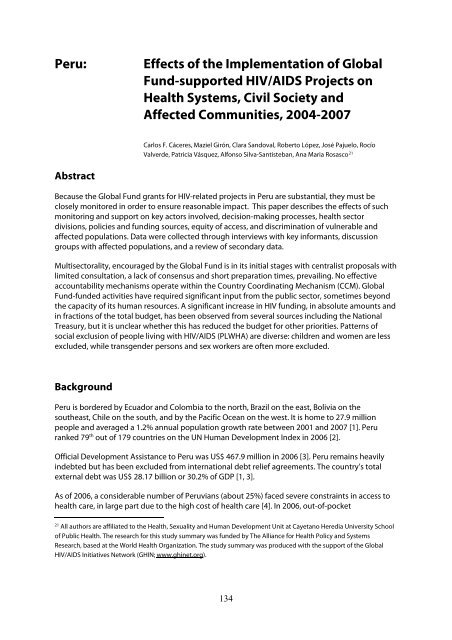MAXIMIZING POSITIVE SYNERGIES - World Health Organization
MAXIMIZING POSITIVE SYNERGIES - World Health Organization
MAXIMIZING POSITIVE SYNERGIES - World Health Organization
Create successful ePaper yourself
Turn your PDF publications into a flip-book with our unique Google optimized e-Paper software.
Peru: Effects of the Implementation of Global<br />
Fund-supported HIV/AIDS Projects on<br />
<strong>Health</strong> Systems, Civil Society and<br />
Affected Communities, 2004-2007<br />
Abstract<br />
Carlos F. Cáceres, Maziel Girón, Clara Sandoval, Roberto López, José Pajuelo, Rocío<br />
Valverde, Patricia Vásquez, Alfonso Silva-Santisteban, Ana Maria Rosasco 21<br />
Because the Global Fund grants for HIV-related projects in Peru are substantial, they must be<br />
closely monitored in order to ensure reasonable impact. This paper describes the effects of such<br />
monitoring and support on key actors involved, decision-making processes, health sector<br />
divisions, policies and funding sources, equity of access, and discrimination of vulnerable and<br />
affected populations. Data were collected through interviews with key informants, discussion<br />
groups with affected populations, and a review of secondary data.<br />
Multisectorality, encouraged by the Global Fund is in its initial stages with centralist proposals with<br />
limited consultation, a lack of consensus and short preparation times, prevailing. No effective<br />
accountability mechanisms operate within the Country Coordinating Mechanism (CCM). Global<br />
Fund-funded activities have required significant input from the public sector, sometimes beyond<br />
the capacity of its human resources. A significant increase in HIV funding, in absolute amounts and<br />
in fractions of the total budget, has been observed from several sources including the National<br />
Treasury, but it is unclear whether this has reduced the budget for other priorities. Patterns of<br />
social exclusion of people living with HIV/AIDS (PLWHA) are diverse: children and women are less<br />
excluded, while transgender persons and sex workers are often more excluded.<br />
Background<br />
Peru is bordered by Ecuador and Colombia to the north, Brazil on the east, Bolivia on the<br />
southeast, Chile on the south, and by the Pacific Ocean on the west. It is home to 27.9 million<br />
people and averaged a 1.2% annual population growth rate between 2001 and 2007 [1]. Peru<br />
ranked 79 th out of 179 countries on the UN Human Development Index in 2006 [2].<br />
Official Development Assistance to Peru was US$ 467.9 million in 2006 [3]. Peru remains heavily<br />
indebted but has been excluded from international debt relief agreements. The country’s total<br />
external debt was US$ 28.17 billion or 30.2% of GDP [1, 3].<br />
As of 2006, a considerable number of Peruvians (about 25%) faced severe constraints in access to<br />
health care, in large part due to the high cost of health care [4]. In 2006, out-of-pocket<br />
21 All authors are affiliated to the <strong>Health</strong>, Sexuality and Human Development Unit at Cayetano Heredia University School<br />
of Public <strong>Health</strong>. The research for this study summary was funded by The Alliance for <strong>Health</strong> Policy and Systems<br />
Research, based at the <strong>World</strong> <strong>Health</strong> <strong>Organization</strong>. The study summary was produced with the support of the Global<br />
HIV/AIDS Initiatives Network (GHIN; www.ghinet.org).<br />
134

















